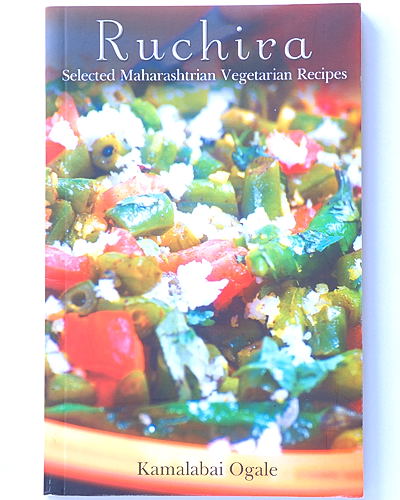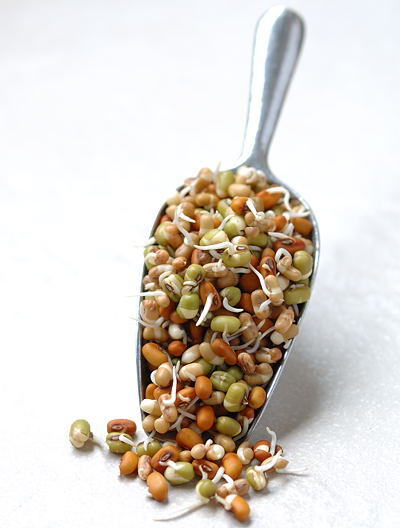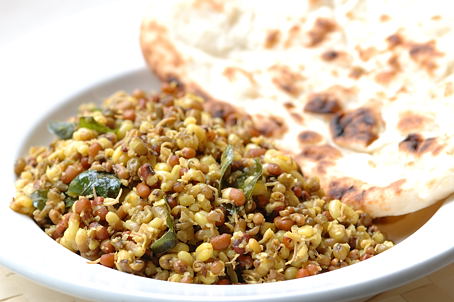
Ruchira by Kamalabai Ogale
“Ruchira ~ Selected Maharashtrian Vegetarian Recipes” by Kamalabai Ogale is a sweet little cookbook that I have been using for just over a year. The cookbook is an English translation of 25-year old original by the same name “Ruchira” in Marathi language.
Ruchira is chock full of honest content. A total of 94 recipes in 11 categories, nearly all recipes are within reach of competent home cooks. Many recipes are quite simple to prepare, the instructions are easy to follow and the rewards are great. The difference is not in the dishes offered, but in the ingredients and how the Marathas use them. The text should be read first to get a feel for the Maharashtrian cooking. Then head for the kitchen to cook one of the divine recipes. Next to going to Maratha heartland, Ruchira offers a great way to treat ourselves to cooking real Marathi way.
If you are looking for a book that will teach you to cook the best Maharashtrian food, then I will definitely recommend Ruchira. It’s a precious little gem!

Sprouted Moong, Moth and Red Chori Beans
“Sprouted Beans Usal” from Ruchira cookbook has become one of my favorite recipes. What makes this recipe standout from our own Nandyala style moog bean curry recipe is the addition of kala masala, and jaggery. Subtly spiced and well balanced, I’ve become a loyal fan of sprouted beans usal.
Recipe:
Grind to Paste:
5 peeled garlic cloves, 8-10 green chillies (small, Indian type), 1 teaspoon cumin and two to four tablespoons of grated fresh coconut.
Heat and Simmer:
Heat a teaspoon of oil in a big saucepan.
Add one cup each – moong, moth and red chori sprouted beans.
Add about three cups of water.
Cover and simmer the beans, until they reach fall-apart stage.
Add and Mix:
To the cooked beans, add the ground paste.
Also a tablespoon each- kala masala and powdered jaggery and
Half teaspoon each – turmeric and salt.
Mix and simmer another five minutes.
If the Usal(curry) looks too dry, add about half cup of water.
Popu or Tadka Touch:
While the beans are simmering with spices, do the tadka in a small pan.
Heat a teaspoon of oil in a pan. Add and toast few fresh curry leaves, pinch of cumin, mustard seeds and asafetida. (This technique is called popu or tadka.)
Add the tadka to the sprouted beans. Mix and turnoff the heat.
Sprouted beans usal tastes great with chapatis/rotis/parathas.

Sprouted Beans Usal with Paratha ~ From Maratha Heartland to Our Home
My Entry to RCI~Maharashtra hosted by Nupur of One Hot Stove
Notes:
Thanks for this lovely gift Veena!
I’ve prepared Kala Masala following the recipe outlined here.
Ruchira Available at Aggarwaloverseas.com
Recommend “Ruchira” to local libraries.

heya,
i’m half maharashtrian and my mom (the marathi half) uses it a lot for traditional recipes alas, a lot would be lost in my translation so its good to know an english version exists!
Me likes usal too..its the only way i like sprouts 😀
woohoo..first to comment 😉
Comment by disha — June 25, 2007 @ 7:58 pm
Thanx for sharing this lovely information.
I have her mararthi version and I always thought Ruchira was published only in Marathi.
Now I can gift this book to non maharashtrian friends who are keen to learn our cuisine 🙂
I liked the systematic way you have described the method of preparing the usal.
Your photos are excellent 🙂
Comment by archana — June 25, 2007 @ 8:14 pm
I think Ruchira is one of the earliest marathi cookbooks published, i.e.when there were not many cookbooks around.And I too didn’t know an English version of this existed.
Your Usal looks just like my Mom’s (I mean it as a compliment :))fabulous
Comment by madhuli — June 25, 2007 @ 8:25 pm
I knew you had a fantastic recipe in store! Thanks for the recipe. K loves sprouts and maharashtrian cuisine.My M-I-L is from there
Comment by Deepika Saripalli — June 25, 2007 @ 8:47 pm
Indira,
This is my favorite usal. My mom used to add ground nuts and I used to pick them and eat:). I have heard many good things about Ruchira, it’s a shame I don’t have it being Marathi. Shall get it the next time I go to India.
Comment by Swapna — June 25, 2007 @ 9:40 pm
I was wondering what recipe you were gonna post with those sprouts 🙂 Thanks for the book reference too. Yr reviews help me to choose cookbooks for my collection.
Comment by Suganya — June 25, 2007 @ 10:03 pm
Indira, very nice looking sabji…thanks for sharing and also the info on the cookbook.
srivalli
Comment by Srivalli — June 26, 2007 @ 12:13 am
I wondered what you were going to do with those colorful sprouts — looks delicious!
Thank you for the detailed cookbook writeup; maybe I’ll be treating myself one of these days 😉
Comment by Linda — June 26, 2007 @ 2:56 am
This looks like a lovely recipe. Thanks Indira, now only if I can get alll those sprouts
Comment by sandeepa — June 26, 2007 @ 6:13 am
hi indira, i hv been a regular visitor of this blog and i do recommend it to many of my friends coz its just amazing! the food is so homely and healthy.. the ingredients easily available.. the pics so tempting! and this recipe is my fav! me being maharashtrian..uve described it in the most aunthentic way possible..thank u
Comment by drshreds — June 26, 2007 @ 8:10 am
Ruchira is the best cookbook for traditinal Marathi vegetarian recipes. I have my mom’s old copy. I read it often because it takes me back to the simple happy times.
Comment by Milli — June 26, 2007 @ 11:16 am
Hello Indira
Where can i find your email address?. I could not find it anywhere on the site…
Comment by Avidreader — June 26, 2007 @ 12:29 pm
Hi Indira, I’m interested to know if you could find the ingredients to make “Kala Masala” in the US.
Comment by Smitha — June 26, 2007 @ 12:31 pm
What a delightful dish! I’ve enjoyed it many a times (since I lived in Pune for a while) and every time I make matki (moth) sprouts, this is my usual method – without the goda masala. 😮
I have all the spices need for goda masala, except sesame seeds which I’ve run out of.. I will try this sometime soon. Thanks for rekindling the memories of this dish, that I had totally forgotten. 🙂
Btw, I also make sprouts in a bigger batch and freeze half of it for later use.. doesn’t taste ‘as’ good as the fresh one, but pretty good.
Comment by Kay — June 26, 2007 @ 1:59 pm
Hi Indira, thanks for sharing such a delightful and healthiest dish.
Comment by Jyothi — June 26, 2007 @ 2:19 pm
Hello Indira,
I have been following your blog for quite sometime and I have to tell you, everytime I open the blog, my mouth waters looking at your preparations. You are amazing girl….
I use bloglines to keep a track of the blogs I visit and for some reason yours does not get updated everytime you post a new blog. Do you know why? If you dont, no problem…
Just wanted to congratulate on your amazing cooking skills and elaborate presentation skills
Comment by spandana — June 26, 2007 @ 2:38 pm
I have this book, but don’t use it all that much. I find its style a bit confusing. It is definitely written assuming one has a strong knowledge of Indian cooking ingredients and techniques, so sometimes I have to extrapolate from a term in the text to a technique or ingredient I know under another name.
I love Marathi food though, so maybe I will give it another shot. So far I’ve only made a few of the koshimbirs. One thing that I’m still baffled by – what’s a “katori”? What does that correspond to in English measurements? I’m all for eyeballing proportions, but I’d like a bit of an idea about where to start.
Comment by Diane — June 26, 2007 @ 7:36 pm
Thank you my dear Marathi friends for your heartwarming comments on my humble attempt. You are the best!
Avid Reader: You can find my email id in Copyright page and in About Mahanandi page.
Smitha: I got mine from India. I think except for one or two, remaining ingredients listed for Kala masala preparation, you can easily get them in any big box type Indian grocery shops, like subji mandi/apna bazar etc.
Spandana: Thanks for you kind words about Mahanandi. I greatly appreciate it!
Here is the link to RSS feed for Mahanandi:
http://nandyala.org/mahanandi/feed
Try this one and please let me know if you face any problems. Thanks.
Diane: My favorites are usals and amti recipes. They are easy to follow and taste great.
About Katori – they mention about that in Foreword.
“The book does away with cumbersome weighing scales and uses a katori(small bowl) and teaspoon easily accessible in Indian kitchens. As long as the size of the katori is consistent, the result will be same.”
Comment by Indira — June 26, 2007 @ 9:49 pm
A very different recipe with three beans..
Comment by prema — June 27, 2007 @ 11:18 am
Hi i liked ur site very nice, impressive so tempting.. i hv lost words..well im writing down almost all the recipes and already planning to do it for my weekend. thnx so much for the recipes.. keep blogging..
Comment by sushma — June 28, 2007 @ 12:41 am
hi
Indira
i have the Marathi version of Ruchira , and its the almost the first well made marathi cooking book in the market, its a boon for newly weds as its written by kamalabai ogle who is quite an elderly person.I am happy that you have made a Maharashtrian recipe and also own the book.
I have one question dont the sprouts require different timings for cooking , does it affect the final product.
Hi Mahek,
I am happy too.
The three beans and sprouts are similar in size, so they do not need separate timings for cooking. If you click on sprouts link, you can find the image of the 3 beans.
Hope this helps.
– Indira
Comment by mahek — June 30, 2007 @ 6:05 am
FYI, saying “the ingredients and how the Marathas use them” is incorrect. ‘Maratha’ doesn’t refer to Maharashtrians, it refers to one caste amongst Maharasthrians. And this recipe book has next to zero Maratha (read: spicy, non veg, mutton or chicken based) recipes. It’s like, not every Tamil cookbook has Aiyyar cooking.
Comment by p — July 15, 2007 @ 12:40 pm
sorry, this is not food-related. have been an admirer of your blog for a while now. however, was deeply offended by the bharat matrimony ad which pops up on your site and then refuses to go away. it’s pat in the middle of the text which then becomes impossible to read. the ad cannot be closed either. what’s up? i realise it’s tempting to make money off one’s blog but surely you want visitors to be able to read it as well.
Hello Amit,
I’m surprised to read this. I would never place ads in such intrusive manner and I have never seen that kind of pop up on my browser. Could you please mail me (mailmahanandi@gmail.com) a screenshot of Mahanandi with this ad pop up. I would greatly appreciate your help.
Also please note that website hosting costs money, particularly for a high trafficked one like mine. Ads are installed not to make money but to cover the website expenditures.
Indira
Comment by Amit Dixit — April 11, 2008 @ 4:14 am
I want to buy RUCHIRA book for my wife.
Where do I get it?
Comment by shailesh — March 10, 2009 @ 1:47 am
Was looking for a review of this book before I bought it. This was useful. Thank you.
Comment by Amitabh Iyer — March 15, 2009 @ 11:32 pm
Hi Indira,
I was looking to buy this book here in the US, but I am unable to find it anywhere. Do you know where I can get it? Also, my parents arent abel to place an English copy anywhere in Pune… 🙁 Where did you get your copy from?
Comment by Sheetal Joshi — October 23, 2010 @ 10:36 pm
@ Sheetal Joshi
You can order the book online from Aggarwaloverseas.com for $4.95 + $5 air shipping to the US. I think that’s a reasonable price. Hope this helps. 😀
Comment by tdigi — October 28, 2010 @ 1:58 am
please tell me do you have Ruchira book in English.
Regards
Shyam
09420858555
Comment by shyam — April 25, 2011 @ 4:48 am
Great recipes! Where can I get a copy of the english version of Ruchira cookbook?
Thanks.
Comment by Shanthi — September 13, 2013 @ 6:04 pm
[…] Other examples are the Bengali Amish o niramish ahar by Prajnasundari Devi, Samaithu Paar by Meenakshiammal, Ruchira by Kamlabai Ogle and Mrs KM Mathews cookbooks. By the 1970s middle class women were more likely to read English periodicals and books but I won’t go into these books here. […]
Pingback by The Food Post | VintageSareeBlouse — March 31, 2015 @ 10:19 am